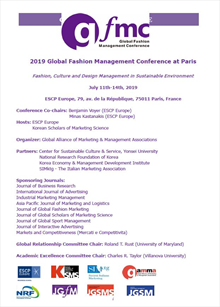간행물
Global Fashion Management Conference

- 발행기관 글로벌지식마케팅경영학회
- 자료유형 학술대회
- 간기 부정기
- ISSN 2288-825X (Print)
- 수록기간 2015 ~ 2024
- 주제분류 사회과학 > 경영학 사회과학 분류의 다른 간행물
- 십진분류KDC 325DDC 330
권호리스트/논문검색
2019 Global Fashion Management Conference at Paris (2019년 7월) 224건
61.
2019.07
구독 인증기관·개인회원 무료
Global Fashion Management Conference
2019 Global Fashion Management Conference at Paris
p.269
글로벌지식마케팅경영학회
62.
2019.07
구독 인증기관·개인회원 무료
Global Fashion Management Conference
2019 Global Fashion Management Conference at Paris
p.270
글로벌지식마케팅경영학회
63.
2019.07
구독 인증기관 무료, 개인회원 유료
Global Fashion Management Conference
2019 Global Fashion Management Conference at Paris
pp.271-276
글로벌지식마케팅경영학회
Unlike slow fashion that takes workers, consumers and environmental welfare into consideration, fast fashion is criticized for neglecting these. This study investigates attitudes and adoption intention of the slow fashion concept among young adults in South Africa, a highly socio-economically unequal emerging market. An extended information adoption model will be adapted and tested through a self-administered survey of 300 respondents. The results will provide marketing professionals, environmental and consumer interest groups and policy makers with valuable insight into barriers and motivators of slow fashion idea adoption among young adults who are a large, influential and profitable consumer segment.
4,000원
64.
2019.07
구독 인증기관 무료, 개인회원 유료
Global Fashion Management Conference
2019 Global Fashion Management Conference at Paris
pp.277-282
글로벌지식마케팅경영학회
Adopting voluntary simplistic lifestyles with practices that are socially and environmentally responsible remain key issues in the quest toward saving the planet. This research explores the prevalence of voluntary simplistic clothing consumption practices among female consumers in South Africa, where dramatic increases in consumption must be curbed.
4,000원
65.
2019.07
구독 인증기관 무료, 개인회원 유료
Global Fashion Management Conference
2019 Global Fashion Management Conference at Paris
pp.283-285
글로벌지식마케팅경영학회
3,000원
66.
2019.07
구독 인증기관 무료, 개인회원 유료
Global Fashion Management Conference
2019 Global Fashion Management Conference at Paris
pp.286-291
글로벌지식마케팅경영학회
This study aimed to identify the key factors influencing the U.S. millennial consumers’ willingness to recycle their denim apparel to brands or retailers. Consumer perceived value model provides the theoretical framework and guides data analysis. Five main values identified are the perceived social, financial, emotional, convenience and ecological values.
4,000원
67.
2019.07
구독 인증기관 무료, 개인회원 유료
Global Fashion Management Conference
2019 Global Fashion Management Conference at Paris
pp.292-296
글로벌지식마케팅경영학회
The resale market of used items selled about U$ 16 billions in 2015 in the US. We interviewed twelve consumers to better understand this phenomenon, Our results showed that consumers choose SHP due to economic reasons, and sustainability is marginally considered. Contamination is the main barrier to consume used products.
4,000원
68.
2019.07
구독 인증기관 무료, 개인회원 유료
Global Fashion Management Conference
2019 Global Fashion Management Conference at Paris
pp.297-302
글로벌지식마케팅경영학회
The study finds placing informational message first generates increased brand attitude for female consumers, while males prefer informational message placed last. High construal level leads to increased brand attitude for both males and females, low construal level consumers do not differ significantly in brand attitude across information order or gender.
4,000원
69.
2019.07
구독 인증기관 무료, 개인회원 유료
Global Fashion Management Conference
2019 Global Fashion Management Conference at Paris
pp.303-309
글로벌지식마케팅경영학회
This research aims to identify the main drivers behind consumers’ connection with fashion brands on social media. With a sample of 29 in-depth interviews with French individuals the study analyzes why and how consumers connect with fashion brands on social media platforms. Our results disclosed three categories of drivers: information with characteristics of information seeking, need for “staying in”, public self-consciousness and tracking promotions; aspirational with characteristics of entertainment, visual enjoyment, and dreaming; and last social with characteristics of need for belonging to brand community, social contamination, and benchmark with reference groups. Theoretical and empirical implications are discussed as well.
4,000원
70.
2019.07
구독 인증기관 무료, 개인회원 유료
Global Fashion Management Conference
2019 Global Fashion Management Conference at Paris
pp.310-313
글로벌지식마케팅경영학회
3,000원
71.
2019.07
구독 인증기관·개인회원 무료
Global Fashion Management Conference
2019 Global Fashion Management Conference at Paris
p.314
글로벌지식마케팅경영학회
72.
2019.07
구독 인증기관 무료, 개인회원 유료
Global Fashion Management Conference
2019 Global Fashion Management Conference at Paris
pp.315-322
글로벌지식마케팅경영학회
This study assesses the fashion blogging content and what type(s) of content categories attract SNS users’ attention on Chinese social networking sites via content analysis and eye-tracking methods. Fashion bloggers need to optimize their content strategies to remain outstanding in competitive online environments. Based on literature review, we generated five content codes social fashion blogging posts, and examine the effect of the posts based on fixation count, the duration, and time to first fixation. Study one categorised posts themes into the codes. Then examine and analysis the frequently used content, how these influence on audience attention through includes total fixation duration (TFD), fixation count (FC) and time to first fixation (TFF). The findings could provide guides for fashion bloggers to generate more effective and engagement content to audiences.
4,000원
73.
2019.07
구독 인증기관·개인회원 무료
STUDY ON THE INFLUENCING OF WEB CELEBRITY ENDORSER ON BRAND EQUITY: RESEARCH BASED ON FASHION BRANDS
Global Fashion Management Conference
2019 Global Fashion Management Conference at Paris
p.323
글로벌지식마케팅경영학회
74.
2019.07
구독 인증기관·개인회원 무료
Global Fashion Management Conference
2019 Global Fashion Management Conference at Paris
p.324
글로벌지식마케팅경영학회
75.
2019.07
구독 인증기관·개인회원 무료
Global Fashion Management Conference
2019 Global Fashion Management Conference at Paris
p.325
글로벌지식마케팅경영학회
76.
2019.07
구독 인증기관 무료, 개인회원 유료
Global Fashion Management Conference
2019 Global Fashion Management Conference at Paris
pp.326-329
글로벌지식마케팅경영학회
3,000원
77.
2019.07
구독 인증기관 무료, 개인회원 유료
Global Fashion Management Conference
2019 Global Fashion Management Conference at Paris
pp.330-334
글로벌지식마케팅경영학회
4,000원
78.
2019.07
구독 인증기관 무료, 개인회원 유료
Global Fashion Management Conference
2019 Global Fashion Management Conference at Paris
pp.335-337
글로벌지식마케팅경영학회
3,000원
79.
2019.07
구독 인증기관·개인회원 무료
Global Fashion Management Conference
2019 Global Fashion Management Conference at Paris
p.338
글로벌지식마케팅경영학회

